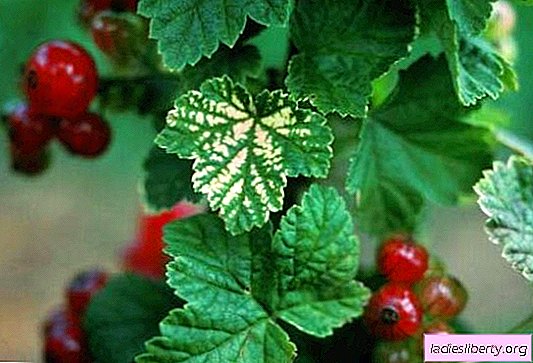
The queen of berries, red currants, with proper maintenance, turns into a real decoration of the garden.
Unfortunately, even the most thorough care does not guarantee the complete absence of fungal and viral diseases to which the plant is predisposed. Nevertheless, the fight against diseases of redcurrant cannot be ignored.
What diseases threaten redcurrant?
Like other species, red currants are susceptible to fungal and viral diseases. The most dangerous among them is terry. This is a very insidious virus, as it develops, changes the appearance of the bush and leads to infertility of currants. Most often, it affects black currants, but since the tick is a vector that settles on red, the bushes with red berries are also not immune to it. If no signs of a kidney tick were found on the currant, then the virus was transferred with planting material or through infected garden tools. Reversion - terry is a popular name - does not develop in one year, and the longer the infected bush remains in place, the higher the risk of disease of other plants.
The presence of the virus during flowering is determined:
• currants lack aroma;
• flowers are ugly, greenish or dirty pink (up to purple), with pointed elongated petals;
• leaves are darker than usual, denser and wider, with three corners instead of five.
Due to the terry, inflorescences do not develop: not having time to give an ovary of berries, they crumble to the ground. The virus is not treated: the infected bush lays down for removal. For several years, currants in this place can not be planted.

Another common virus is striped mosaic. A bright pattern appears on the leaves of the infected plant along the veins, gradually filling the entire surface of the leaf. This leads to a decrease and a complete lack of yield and death of the plant. As with terry, the bush with the virus is uprooted and burned.
Redcurrant: disease and treatment. How to defeat anthracnose?
In common people they call him a fly-fly. For red currants, it is even more fatal than for black or white. Infection can be identified by spots: first, small brown spots on the leaves gradually increase in size, and, merging, form tubercles that deform and disfigure the leaves.

This leads to their decline: in red currants, even a few spots can cause premature leaf discharge and a sharp decrease in yield.
It is good that anthracnose is treatable:
• spraying the bush and the earth around it with a solution of copper sulfate or Nitrafen: this must be done before buds open;
• three-time spraying with a 1% solution of Bordeaux fluid after flowering with a frequency of two weeks;
• Recommended fungicides "Titan", "Agrolekar", "Title 390".
Prevention of the disease gives a very good result, not allowing spores of the fungus to spread through the garden:
• in the fall and spring, the soil around the bush is dug up;
• fallen leaves, in which the fungus winters, are collected and burned;
• do not allow bush thickening and carry out timely pruning;
• scald garden equipment with boiling water before use so as not to transfer spores to healthy plants.
Since anthracnose, in addition to leaves, affects the stalks and shoots, the treatment should be quick and comprehensive.
Ball rust
One of the most unpleasant diseases. The lower surface of the leaf is covered with small orange spots, which, if not taken, grow into “glasses”: it is in them that the spores of the fungus ripen, which at the end of the summer are transferred by wind to neighboring bushes and ... sedge. If there are thickets within a half kilometer from the site, it is from there that the rust flew into your site. It is imperative to get rid of sedge: in the spring it transfers the spores of rust to the currant with the wind.

In addition to the standard treatment with Bordeaux liquid and fungicides, there is a proven folk recipe:
• make two infusions: for the first take 1 cup of garlic cloves and 2 l of water, for the second 200 g of tobacco and 3 l of water. Keep both infusions in a dark place for 2-3 days, strain, and then drain into a bucket of 10 liters;
• add 1 tsp to the bucket ground pepper, 1 tbsp. l any liquid soap, insist 3 hours, strain.
The composition is prepared in advance: you need to spray plants to fight diseases of red currant before flowering. The remainder of garlic, tobacco and pepper can be used as mulch. After a couple of weeks, the bush is sprayed with infusion of onion husks.
And if there is no confidence in folk remedies, then you can purchase special drugs: Agrolekar, PropiPlus, Prognoz, and Chistoflor.
Redcurrant Septoria
It should be noted that red currants are not as often affected by white spotting as other species. However, sometimes this happens - which means that it is necessary to treat.
The disease begins with the appearance of brown spots. As they grow, the center of the spot fades, and as a result, a large gray-white spot with a brown border remains on the sheet plate.

Septoria is treated with almost the same methods as anthracnose, its pathogen also tolerates winter in fallen leaves. In addition, you can use fungicides: "Tsikhom", "Fitosporin-M", "Chistoflor" and "Forecast". To prevent the onset of the disease, a currant bush is sprayed with Bordeaux liquid, copper sulphate or Nitrafen before flowering. Mandatory thinning of the bush and removal of shoots with signs of septoria.
Sferoteka red currant: what is this disease? Powdery Mildew Treatment
The name "powdery mildew" is more familiar to the gardener. This disease causes a lot of trouble with its frequent relapses, but it is already well known and studied, so there is a chance to win. Signs of damage to the currant with powdery mildew:
• the appearance on the leaves and fruits of a light gray coating, which gradually acquires a brown color;
• leaf deformation: curling, shedding;
• cessation of growth;
• falling of unripe berries.

The danger of the sphere is that, due to growth disorders, the plant becomes less winter-hardy, and if it survives the winter, powdery mildew will completely defeat the bush next year and move on to the next plant.
Control measures include:
• complete spraying of currants with fungicides;
• folk remedy: soda ash solution (50 g per 10 l of water);
• prepare a solution of mullein and water in a ratio of 1: 3, insist 3 days, once again breed in the same proportion and spray the infected bush weekly.
Of the fungicides, Alirin-B, Bactofit, Tiovit Jet, Fitosporin-M, Topaz can be used.
There are also preventive measures against mildew. This is a mandatory pruning of damaged shoots, cleaning and burning of fallen leaves. This can not be neglected, because if you do not destroy the infected parts of the plant, then the spores of the pathogen fungus will sooner or later end up on other plants, and the entire course of treatment will have to be started again.
In general, methods for combating redcurrant diseases do not differ from treating bushes with black or white berries. It’s just that it is subject to some diseases more or less: this must be taken into account before starting treatment in order to manage to save the plant.











